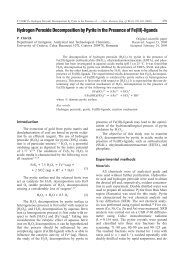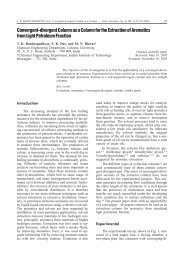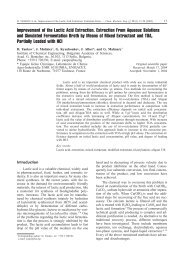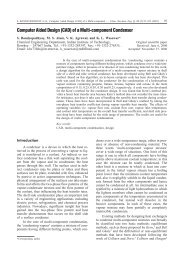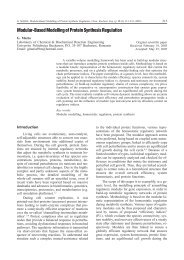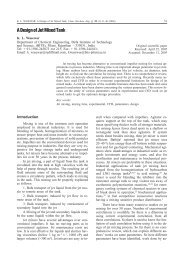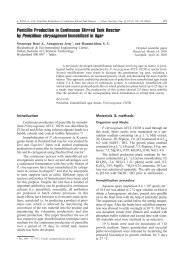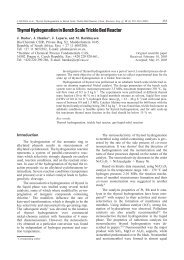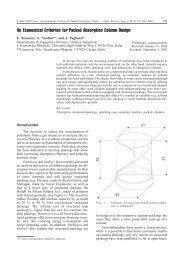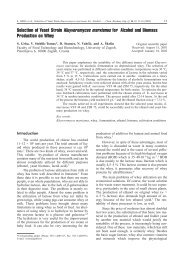58 S. BHARGAV et al., <strong>Solid</strong>-state <strong>Fermentation</strong>: <strong>An</strong> <strong>Overview</strong>, Chem. Biochem. Eng. Q. 22 (1) 49–70 (2008)mal stability, and activity at mesophillic temperaturesare generally utilized in chemical processes. 85Some of the agro-industrial wastes used in SSFfor lipase production are babassu oil cake, wheatbran, rice bran, gingelly oil cake, almond meal,mustard meal, coconut meal, rice husk, sugarcanebagasse, cassava bagasse, coconut oil cake, olive oilcake, etc.CellulaseCellulase is an enzyme complex used for theconversion of lignocellulosic residues and used forproduction of ethanol, single-cell protein, bleachingof pulp, for treatment of waste papers and for fruitjuice extraction. In SSF, using lignocellulosicwastes as substrates can reduce the cost of cellulaseproduction. 61 Lignocellulosic materials are cheaperand pretreatment is required to improve their utilization.Pretreatment of lignocellulosic matrix increasesthe potential of cellulases to act oncellulose, hemicelluloses.The concerted action of enzymes like endoglucanases,exoglucanases and - glucosidase isused for hydrolyzing cellulose. The rate-limitingstep is the ability of endoglucanases to reach amorphousregions within the crystalline matrix and createnew ends with which endoglucanases can act. 86Ethanol production from lignocellulose biomass requireshydrolysis by cellulase and hemicellulase forconverting lignocellulosic biomass to biofuel. 87Some factors like moisture content, particlesize, pH, incubation temperature, inoculum size, incubationperiod and enrichment of medium withcarbon and nitrogen were considered optimum forcellulase production by bacterial strain Bacillussubtilis on banana fruit stalk wastes. However, totalenzyme production was 12 times higher in SSFthan in submerged fermentation under similar experimentalcondition. 88 It is necessary to considerthese factors for cellulase production from lignocellulosicwastes as their nutrients are already depleted.Water content of substrate and aeration rate arecritical factors in cellulase production using SSF.Corncob residue was used for cellulase productionwith Trichoderma reesei ZU02 in shallow tray fermentors.Xia and Cen used a deep trough fermentorwith forced aeration for cellulase production.Forced aeration enhanced the mass transfer to agreater extent, which increased cellulase activity to305 IU per g of cellulose. 61 It has been reported byFujian et al. that substrates in solid-state with continuouscirculation of air and convective diffusionwith pressure are better for fungal propagation thanstatic cultures. This periodic air circulation increasesthe looseness of substrates and enhancescellulase activity. The filter paper activity of cellulaseenzyme increased to 20.4 IU g –1 at a bed heightof h = 9cm in t = 60 h, while maximum filter paperenzyme activity was 10.8 IU g –1 in 84 h withinstatic cultures. The work was performed usingsteam-exploded wheat straw as carrier with Penicillumdecumbens in SSF. 89 However, changes inthe amplitude of air pressure increased the oxygenavailability to the cultures used and heat removal.The variations enhanced the cellulase production byTrichoderma viride in SSF. 90Co culturing of two fungi in SSF enhances theenzyme production. Co culturing of Trichodermareesei mutants with Aspergillus spp. increased thecellulase production by 50 % and improved thecellulase glucosidase ratio, by partially removingproduct inhibition and its hydrolysis. 91 Co culturingAspergillus ellipticus and Aspergillus fumigatus resultedin improved hydrolytic and -glucosidaes activity.61,71 However, some newly developed agro-industrialwastes used for cellulase production arebanana wastes, rice straw, corn cob residue, ricehusk, wheat straw, banana fruit stalk, and coconutcoir pith.PectinasePectinases are constitutive or inducible enzymesproduced by microbes for breaking pectin.Different substrates used for production of pectinaseare wheat bran, soy bran, apple pomace, cranberrypomace, strawberry pomace, beet pulp, coffeepulp & husk, cocoa, lemon & orange peel, combinationof sugarcane bagasse and orange bagasse,wheat bran etc.Production of polygalactouronase (PG) andpectinesterase (PE) was 6.4 times higher in SSFcompared to submerged fermentation. PE and PGactivity was measured to be 500 U L –1 and 350UL –1 at 24 h of incubation with pectin as the solecarbon source with SSF, but in submerged fermentationenzyme production was 127 U L –1 and 55UL –1 at t = 48 h of incubation. Supplementation ofglucose decreased the production of enzymes due tocatabolite repression in submerged fermentation.However, PE and PG enzymes increased by 30 %and 33 % respectively with addition of glucose. 92Similarly, exopectinase activity increased from 623to 7150 (IU L –1 ) in SSF, but decreased from 1714 to355 (IU L –1 ) in submerged fermentation in the presenceof sucrose at A w of 0.995. Similar results wereat A w of 0.96. Increase in water activity increasedpectinase activity in SSF. 93 Production usingdeseeded sunflower head as substrate resulted instep-up of exopectinase and endopectinase enzymeusing SSF. In SMF the endopectinase was 18.9UmL –1 , which increased to 19.8 U mL –1 in SSF.
S. BHARGAV et al., <strong>Solid</strong>-state <strong>Fermentation</strong>: <strong>An</strong> <strong>Overview</strong>, Chem. Biochem. Eng. Q. 22 (1) 49–70 (2008) 59Similarly, exopectinase increased from 30.3 U mL –1in SMF to 45.9U mL –1 in SSF, at optimummoisture of s = 65 % and particle size of d = 500m. 94,95 Polyurethane, when used as inert supportfor exopectinase production using Aspergillus nigerin Erlenmeyer flasks, resulted in direct measurementof biomass production, substrate uptake andenzyme activity in culture medium. 93 Botella et al.used grape pomace for exopectinase productionwith Aspergillus awamori in SSF. Initial substratemoisture content of 65 % and supplementation of6 % glucose as carbon source enhanced enzyme activity.However, particle size did not influence theincreased enzyme production, which is contradictoryto earlier reports. 96,97Besides moisture, the production of pectinaseenzymes also depends on physical parameters ofthe bioreactor used, amount of substrate used, typeand pH of substrate and supplements added duringfermentation. A mixture of orange bagasse, wheatbran (1:1) was used for production of endo-polygalactouronase,exo-polygalactouronase and pectinlyaseby Penicillum viridicatum in Erlenmeyerflasks and polypropylene packs at 2 different moistures = 70 %, 80 %. However higher production ofall three enzymes was obtained in polypropylenepacks at s = 70 % moisture, but lower moisture contentwas highly significant for Pectinlyase production.Increase in pectinase enzymes using polypropylenepacks favored it for scale-up. 98Martins et al. used the Thermoascus auranticusfor pectinlyase and polygalactouronase production.The quantity of pectinlyase and polygalactouronasewas found to be higher when compared with otherpectinolytic strains such as Aspergillus niger,Penicillumitalicum,Aspergillus foetidus. However, additionof fibrous material such as sugarcane bagasseto the mixture of wheat bran, orange bagasse, resultedin intra-particle spacing, causing increase inaeration, nutrient and enzyme diffusion, which supportedpectinlyase production. These results provedthat media composition did not affect polygalactouronaseproduction. 99 Pectinase and polygalactouronaseusing Moniellia,Penicillum spp. wereproduced using orange bagasse, sugarcane bagasseand wheat bran as substrate. Addition of fibrousmaterial such as sugarcane bagasse caused interparticlespacing resulting in increase of aeration andnutrients supply. However, sugarcane bagasse asthe sole carbon source, did not allow the growth offungi, indicating that microorganisms are unable tohydrolyze cellulose, hemicelluloses fibers but theycan support mycelia formation. The sugarcane bagassewas used as the inert support for growth &pectinase production by Aspergillus niger,Penicillumviridicatum,Thermoascus auranticus. 100<strong>Solid</strong> substrates resulted in higher pectinaseproduction as they supply nutrients to microbialcultures along with anchorage. Nutrients, which areunavailable or are in sub-optimal concentration, areusually supplemented externally. A Bacillus sp.DT 7 was used for production of pectinase usingwheat bran, rice bran, apple pomace as substrates inErlenmeyer flasks. Maximal enzyme productionwas obtained from wheat bran supplemented withpolygalactouronic acid and neurobion. Supplementationof 27 L of neurobion enhanced pectinaseproduction by 65.8 %. 101PhytaseSeveral strains of bacteria, yeasts, fungi suchas Bacillus subtillis,E. coli,Bacillus amyloliquefaciens,Schwanniomycescastellii,Schwanniomycesoccidentalis,Hansenula polymorpha,Aspergillusflavipes,Aspergillus fumigatus,Aspergillus oryzaeand Aspergillus ficcum are employed for phytaseproduction in SSF systems. Some of the substratesgenerally used for phytase production are canolameal, coconut oil cake, wheat bran, black beanflour, cowpea meal, mustard cake, cotton cake,palm kernel cake, sesame oil cake, rapeseed meal,olive oil cake, groundnut oil cake etc.Phytase production increases with fermentationof mixed substrates. The increase may be due to theavailability of different nutrients from different substratesin the same reactor simultaneously. This maystep-up phytase production. Roopesh et al. usedSSF for phytase production from various substratecombinations of wheat bran and various oil cakesusing Mucor racemosus under SSF. Combination ofwheat bran and oil cake yielded greater Phytasewhen compared to their individual production. Optimizationof conditions resulted in 44.5 U g –1 ofphytase with the combination of wheat bran and oilcake, which were 1.5 times and 4 times higher, respectively,when the oil cake and wheat bran wereused as substrates. The type of carbon and nitrogensource used is an important factor for considerationin any fermentation process. 102 However, alongwith imbalance in the carbon-to-nitrogen ratio,many parameters affect phytase production such asincubation time, initial moisture content and incubationtemperature. Similarly, Ramachandran et al.used Rhizopus spp. with coconut oil cake, sesameoil cake, palm kernel cake, groundnut oil cake, cottonseedoil cake and olive oil cake for phytase production.Cottonseed oil cake and olive oil cakepoorly supported the phytase production individually,but mixed substrate fermentation of bothincreased enzyme production to 35 U/gds.Supplementation of glucose further enhancedphytase activity to 52 U/gds. Enhancement was re-
- Page 1 and 2: S. BHARGAV et al., Solid-state Ferm
- Page 3 and 4: S. BHARGAV et al., Solid-state Ferm
- Page 6 and 7: 54 S. BHARGAV et al., Solid-state F
- Page 8 and 9: 56 S. BHARGAV et al., Solid-state F
- Page 12 and 13: 60 S. BHARGAV et al., Solid-state F
- Page 14 and 15: 62 S. BHARGAV et al., Solid-state F
- Page 16 and 17: 64 S. BHARGAV et al., Solid-state F
- Page 18 and 19: 66 S. BHARGAV et al., Solid-state F
- Page 20 and 21: 68 S. BHARGAV et al., Solid-state F
- Page 22: 70 S. BHARGAV et al., Solid-state F



